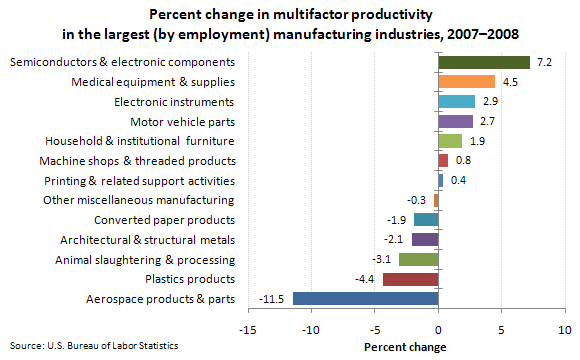Among the largest manufacturing industries (those with employment greater than 300,000), multifactor productivity rose most during 2008 in the semiconductors and electronics components industry, followed by the medical equipment and supplies industry. This is according to new information released by the U.S. Department of Labor's Bureau of Labor Statistics.
Multifactor productivity rose modestly in the largest manufacturing industry, printing and related support activities. Aerospace products and parts posted the largest multifactor productivity decline in 2008 among the largest manufacturing industries.
Output rose in only 17 of 86 manufacturing industries in 2008, compared with 39 in 2007. Combined inputs fell in more industries, 65 in 2008 compared with 54 in 2007. Labor hours fell in 67 manufacturing industries in 2008, while intermediate inputs fell in 65 industries and capital services fell in 43 industries.
Fewer manufacturing industries recorded multifactor productivity increases in 2008 than in any year since 2001. Multifactor productivity increased in about 40 percent of the 86 four-digit NAICS manufacturing industries in 2008. This was down from 2007, when multifactor productivity increased in about 60 percent of those industries.
This data is from the Multifactor Productivity program. See "Multifactor Productivity Trends for Detailed Industries, 2008," news release USDL-10-1351 (HTML) (PDF), to learn more. Multifactor productivity growth measures the extent to which output has grown faster than measured inputs, and reflects the joint influences on economic growth of a number of factors, including technological change, returns to scale, improved skills of the workforce, better management techniques, or other efficiency improvements.





